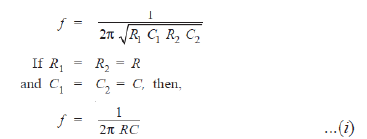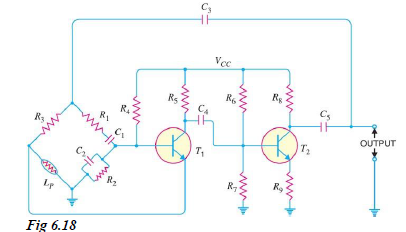- The Wien-bridge oscillator is the standard oscillator circuit for all frequencies in the range of 10 Hz to about 1 MHz. It is the most frequently used type of audio oscillator as the output is free from circuit fluctuations and ambient temperature. Fig. 6.18 shows the circuit of Wien bridge oscillator.
It is essentially a two-stage amplifier with R-C bridge circuit. The bridge circuit has the arms R
1C
1, R
3, R
2C
2 and tungsten lamp L
p. Resistances R
3 and L
p are used to stabilise the amplitude of the output. The transistor T
1 serves as an oscillator and amplifier while the other transistor T
2 serves as an inverter (i.e. to produce a phase shift of 180º). The circuit uses positive and negative feedbacks.
- The positive feedback is through R
1C
1, C
2R
2 to the transistor T
1. The negative feedback is through the voltage divider to the input of transistor T
2. The frequency of oscillations is determined by the series element R
1C
1 and parallel element R
2C
2 of the bridge.


- When the circuit is started, bridge circuit produces oscillations of frequency determined by exp.(i) above. The two transistors produce a total phase shift of 360º so that proper positive feedback is ensured.
- The negative feedback in the circuit ensures constant output. This is achieved by the temperature sensitive tungsten lamp L
p. Its resistance increases with current. Should the amplitude of output tend to increase, more current would provide more negative feedback. The result is that the output would return to original value. A reverse action would take place if the output tends to decrease.
Wilfykil answered the question on
August 15, 2019 at 13:00